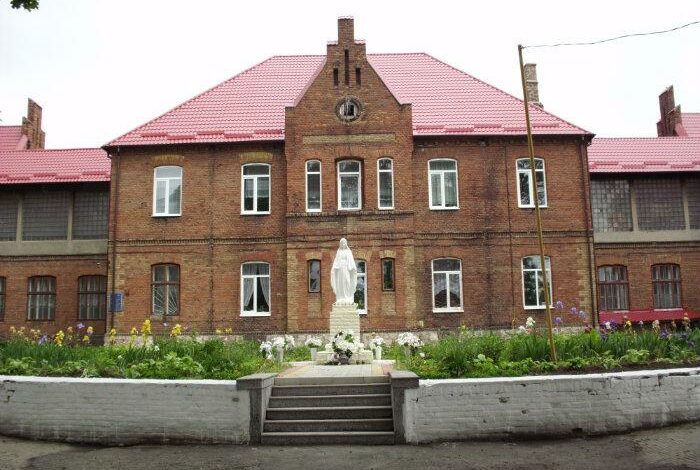
Sokal / 75 Markiyana Shashkevycha Street. The so-called “Red Hospital”. Former county hospital, late nineteenth century.
The first large medical institutions began to appear in Prybuzhzhia during the Austrian period. In September 1878, a hospital was opened in Sokal. It was built at the expense of gminas, the county council, owners of yards and manors, and named after the Austrian Archduchess Gisela [1].
You will be interested: The Mother of God is a silent witness of our downfalls, our callousness and faith in mercy
Thanks to nurse Antonina Hryniuk, the sculpture was found. It was restored with donations from medical staff, patients, and residents of Sokal and is now standing in its original place.
This hospital was designed for 80 beds. The value of all its property was 160,000 crowns. It employed only two doctors. Their number did not increase later. At least it is known that in 1914 the Archduchess Gisela’s Sokal district hospital had only “doctors” Yevhen Weigel and Myron Yayus, and the duties of the lower medical staff were performed by Josaphat sisters.
Until the early 1930s, the Sokal district hospital did not have a single department. There was only an isolation pavilion and a chemical workroom [2]. Now it houses several departments of the district central hospital.
The medical care provided to women in labour in Prybuzhzhia in the last century was somewhat unusual for today’s times. This was done by women midwives. Local historian B. Sokalskyi wrote about the course of such procedures:
“Rural women, being in a state of ‘blessedness’, devote themselves to household chores until the last minute and only in the last critical moment call for a midwife, who mostly arrives after childbirth to perform the usual services around the mother and child. A few hours after giving birth, the woman gets up and starts to spin around preparing meals for guests and relatives, who were followed by her husband” [3].
A significant part of the population of the Sokal region did not seek medical care from doctors, but preferred various witch doctors who allegedly had the power to cast spells to cure illness. This was one of the reasons for the increase in mortality. Per 1000 inhabitants of the Sokal district, 30.5 people died in 1878, 27.7 in 1879, 29.1 in 1880, 35.0 in 1881, and 38.9 in 1882. [4]
Poverty and malnutrition contributed significantly to the spread of disease.
Between 1876 and 1885, tuberculosis (2578 people), whooping cough (1588), typhoid (1301), diphtheria (963), scarlet fever (774) took the most residents of the district to their graves… The infant mortality rate was high.
Before the First World War, there were five pharmacies in the district: in Sokal (owned by Jevhen Wysochanski Minkowicz), Belz (Jan Gross), Tartak (Karol Wojda), Waryazh (Czesław Minnicki), and Krystynopol (administrator Karol Lichtenthal).
During the period of the Polish sanation state, there were no dramatic changes in improving the healthcare of the district’s residents. Only eight medical staff members worked in the Sokal hospital. However, there were capable doctors here. One of them was O. Pelekh, who later headed this medical institution and implemented the progressive achievements of the medical science of the time. A talented doctor T. Savka worked in Krytynopol in the 1930s. His good reputation spread among the peasants of the neighbouring villages. Later, he treated UPA soldiers* and saved many of their lives.
With the establishment of Soviet rule, fourteen doctors, one paramedic, three midwives and 17 nurses started working in the district hospital. But progress in healthcare began in the 60s and 70s. In 1981, a new district central hospital was opened in Sokal. In addition to it, medical care for the residents of Sokal district is now provided by Velykomostiv and Belzka hospitals and a drug treatment unit in Uhnovo, which have 735 beds, 10 outpatient clinics and 51 paramedic and obstetric stations. They employ 205 doctors and 697 nurses, 494 junior and service staff.
Sokal also has a state district sanitary and epidemiological station, a blood transfusion station, a preventive and disinfection department, 7 pharmacies, a private company “Provizor” and a limited liability company “Zdorovye”. In addition, there are three polyclinics in the district – Sokal, Velykomostiv and Belzka. The Sokal Pharmacy has its branches in six villages of the district.
Despite this, morbidity and mortality among the rural population have recently been on the rise. The demographic figures for the district in 1997 were as follows: the birth rate per 1000 people was 11.8, the death rate 13.8 and the average life expectancy 69.8.
In 1999 the natural increase in the population of the Sokal district decreased by 4.4 per cent (against 1.8 in 1998). By 660 people more died than were born.
As of 1 January 2000, 1,389 children in the district were diagnosed with hypoplasia of the tooth enamel. However, in recent years there has been a downward trend in the number of these patients.
Among the problems of healthcare facilities is the insufficient allocation of funds for medicines. Patients had to buy them with their own money. However, the staff of the Central District Hospital, headed by Arkadiy Kalishchuk, PhD, is coping well with its duties.
[1] Szematyzm krolestwa Galicyi I Lodomeryi z wielkiem ksiestwem Krakowskiem na rok 1914. Lwow, 1914. S. 524.
[2] DALO. F. 1, op. 9, p. 1785, p. 168.
[3] Sokalski Bronislaw. Powiat Sokalski pod wzglendem geograficznym, etnograficznym, historiograficznym I ekonomichnym. Lwow, 1899. S.85.
[4] Rocznik statystyki Galicyi. Lwow, 1886. T. 1. S. 37.
Source of information
http://www.sokal.lviv.ua/history-vashkiv-sokal_i_prybuzhzhia__41.html

